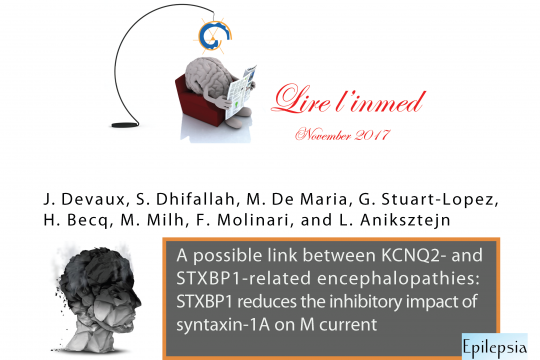Burn out. Mutation in the syntaxin binding protein 1 (STXBP1) and mutation in Kv7 potassium channels all produce early onset epileptic encephalopathies (EOEE) suggesting the two proteins are linked. Here the authors found that in native condition STXBP1 interfered with the interaction of Kv7 and its inhitor Syn-1A. The knock-down of STXBP1 production in EOEE liberated this interaction from its watchdog with the fatal consequence of inhibiting durably potassium channels. Hence, the balance of Syn-1A and STXBP1 is key for keeping neuronal excitability in the brain operational range. (Ingrid Bureau)
Summary
Objective: Kv7 channels mediate the voltage-gated M-type potassium current. Reduction of M current due to KCNQ2 mutations causes early onset epileptic encephalopathies (EOEEs). Mutations in STXBP1 encoding the syntaxin binding protein 1 can produce a phenotype similar to that of KCNQ2 mutations, suggesting a possible link between STXBP1 and Kv7 channels. These channels are known to be modulated by syntaxin-1A (Syn-1A) that binds to the C-terminal domain of the Kv7.2 subunit and strongly inhibits M current. Here, we investigated whether STXBP1could prevent this inhibitory effect of Syn-1A and analyzed the conséquences of two mutations in STXBP1 associated with EOEEs.
Results: Syn-1A decreased M currents mediated by Kv7.2 or Kv7.2/Kv7.3 channels. STXBP1 had no direct effects on M current but dampened the inhibition produced by Syn-1A by abrogating Syn-1A binding to Kv7 channels. The mutation p.W28*, but not p.P480L, failed to rescue M current from Syn-1A inhibition. Biochemical analysis showed that unlike the mutation p.W28*, the mutation p.P480L did not affect STXBP1 expression and reduced the interaction of Syn-1A with Kv7 channels.
Significance: These data indicate that there is a functional link between STXBP1 and Kv7 channels via Syn-1A, which may be important for regulating M-channel activity and neuronal excitability. They suggest also that a defect in Kv7 channel activity or regulation could be one of the consequences of some STXBP1 mutations associated with EOEEs. Furthermore, our data reveal that STXBP1 mutations associated with the Ohtahara syndrome do not necessarily result in protein haploinsufficiency.
Publication here

